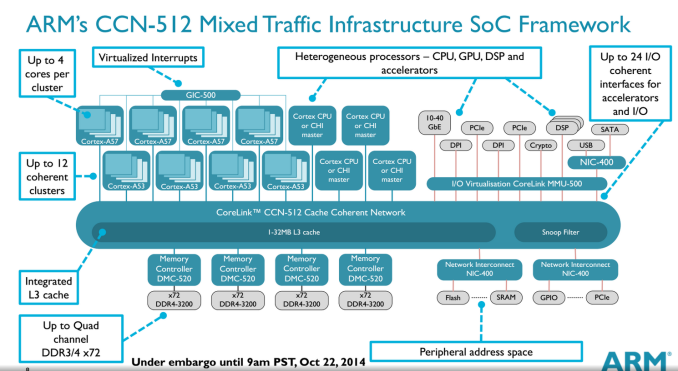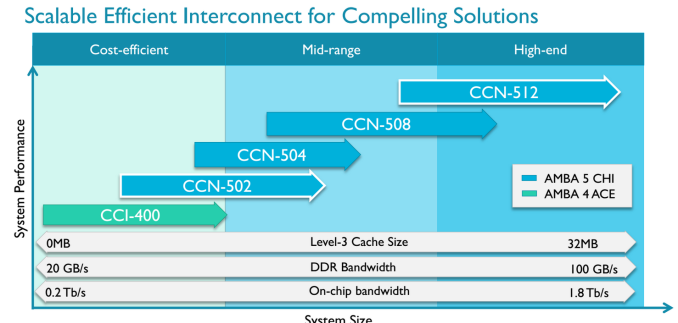ARM Challenging Intel in the Server Market: An Overview
by Johan De Gelas on December 16, 2014 10:00 AM ESTAMD Opteron A1100
The 28nm octal-core AMD Opteron A1100 is a lot more modest and aims at the low end Xeon E3s. Stephen has described the chip in more detail. To ensure a quick time to market, the AMD Opteron A1100 is made of existing building blocks already designed by ARM: the Cortex-A57 core and the Cache Coherent Network or CCN.
The AMD Opteron A1100 is one of the few vendors that uses the ARM interconnect. ARM put a lot of work into this design to enable ARM licensees to build SoCs with lots of accelerators and cores. CCN is thus a way of attaching all kinds of cores, processors, and co-processors ("accelerators") coherently to a fast crossbar, which also connects to four 64-bit memory controllers, integrated NICs, and L3 cache. CCN is very comparable to the ring bus found inside all Xeon processors beginning with "Sandy Bridge". The top model is the CCN-512 which supports up to 12 clusters of quad-cores. This could result in an SoC with 32 (8x4) A57 cores and four accelerators for example.
AMD would not tell us which CCN they are using but we suspect that it is CCN-504. The reason is this CCN was available around the time work started on the Opteron A1100 and the fact that AMD mentions the ARM bus architecture AMBA 5 in their slides. And it also makes sense: the CCN-504 supports up to 4 x 4 cores and supports the Cortex-A57.
It was rumored that the A1100 still used the CCI-400 interconnect, which is used by smartphone SoCs, but that interconnect uses the AMBA 4 architecture. Meanwhile the CCN-502 was announced in October 2014, way too late to be inside the A1100.
The AMD Opteron A1100 consists of four pairs of "standard" triple issue Cortex-A57 cores and 1MB L2 cache, with 8MB L3 cache.
The key differentiator is the cryptographic processor that can accelerate RSA (Secure Connection/hand shake) and AES (encrypting the data you send and receive) and SHA (part of the authentication). Intel uses the PCIe Quick Assist 89xx-SCC add-in card or the special Intel Communication chipset to provide a cryptographic coprocessor. These coprocessors are mostly used in professional firewalls/routers. As far as we know such cryptographic processors are of limited use in most https web services. Most modern x86 cores now support AES-NI, and these instructions are well supported. As a result, the current x86 CPUs from AMD and Intel outperform many co-processors when it comes to real world AES encoding/decoding of encrypted data streams.
A cryptographic coprocessor could still be useful for the RSA asymmetric encrypted handshake, but it remains to be seen if offloading the handshakes will really be faster than letting the CPU take care of it, as each offload operation causes all kinds of overhead (such as a system call). A cryptographic coprocessor running on the same coherent network as the main cores could be a lot more efficient than a PCIe device though. It has a lot of potential, but AMD could not give us much info on the current state of software support.














78 Comments
View All Comments
patrickjchase - Thursday, December 18, 2014 - link
It's been a while since I worked on this stuff, but I don't think that the statement that "CCN is very comparable to the ring bus found inside all Xeon processors beginning with Sandy Bridge" is quite right.CCN
patrickjchase - Thursday, December 18, 2014 - link
Finishing my comment:CCN
stefstef - Wednesday, December 17, 2014 - link
the idea of having an energy efficient design certainly will pay off. nvidia and samsung showed that having i.e. 4 cores and a fifth core dedicated to the energy management can be a good low cost solution. i dont often read the articles at anandtech because they are usually boring. although i am happy to place a coment here. arm rules in certain fields but in a couple of years only because intel will allow them to do so. every company needs a room to live in. another american breakfast for the chinese who will get their share in the processor market as well.milli - Thursday, December 18, 2014 - link
I don't understand how ARM is suddenly going to succeed while MIPS and PowerPC have already tried and failed. I feel that ARM is more of a market trend than anything else (in the server market).Even the current ARM server SOC manufacturers have already tried to penetrate the server market. Cavium and Broadcom already had custom designed low-power MIPS SOCs. IBM, Applied Micro and Freescale have had a bunch of low-power PowerPC options.
By the time any of these products is released, Intel is going to have a better alternative thanks to their process advantage. No IT manager is going to manage to convince any of the corporate fat-cats that a huge overhaul is needed. Same story over again.
yuhong - Friday, December 19, 2014 - link
"Unfortunately their 16GB DIMMs will only work with the Atom C2000, leading to the weird situation that the Atom C2000 supports more memory than the more powerful Xeon E3."I think the reason is software related. More precisely, the Memory Reference Code (MRC).
intiims - Tuesday, December 30, 2014 - link
If You want to know something about External Hard Drives visit http://www.hddmag.com/adrian1987 - Monday, January 5, 2015 - link
Hi. The Haswell core can actually have a max IPC of 6 instructions per cycle using macro-fusion not 5 as listed here (assuming the code is ideal). It has 2 execution units that can handle fused ALU and branch instructions. Source: http://www.anandtech.com/show/6355/intels-haswell-...aaronjoue - Tuesday, April 7, 2015 - link
Here is the real micro server. http://www.ambedded.com.tw/pt_list.php?CM_ID=20140...http://wiki.ambedded.com.tw/index.php?title=MicroS...
7 & 21 nodes in a chassis
It support Ubuntu and open source Ceph.